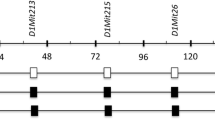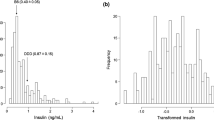Abstract
We previously reported a quantitative trait locus for body weight, non-insulin-dependent diabetes 5 (Nidd5), on Chromosome 2 in the TSOD (Tsumura, Suzuki, Obese Diabetes) mouse, a model of polygenic obese type 2 diabetes. To find the gene responsible for a specific component of the pathogenesis, we used a marker-assisted selection protocol to produce congenic strains. These mice are designed to carry a control BALB/cA-derived genomic interval and a TSOD background to look for loss of phenotype. One of the strains with the widest congenic interval, D2Mit297-D2Mit304, showed reductions in both body weight and adiposity compared with TSOD mice. The phenotypic analyses of other congenic strains further narrowed the locus in a 9.4-Mb interval between D2Mit433 and D2Mit91, around which numerous loci for body weight and adiposity have been mapped previously. Although the locus showed a relatively modest effect on body weight, it had a major influence on fat mass that explains approximately 60% of the difference in the adipose index between parental TSOD and BALB/cA mice. Furthermore, the congenic strain with a minimal BALB/cA-derived region showed significantly smaller cell sizes of white and brown adipocytes compared with the control littermates. However, the locus did not primarily affect food consumption, general activity, or rectal temperature after cold exposure, although there are clear differences in these traits between the parental strains. The present work physically delineates the major locus for adiposity in the TSOD mouse.





Similar content being viewed by others
References
Bell CG, Walley AJ, Froguel P (2005) The genetics of human obesity. Nat Rev Genet 6: 221–234
Bradshaw AD, Graves DC, Motamed K, Sage EH (2003) SPARC-null mice exhibit increased adiposity without significant differences in overall body weight. Proc Natl Acad Sci U S A 100: 6045–6050
Brockmann GA, Bevova MR (2002) Using mouse models to dissect the genetics of obesity. Trends Genet 18: 367–376
Brown LJ, Koza RA, Everett C, Reitman ML, Marshall L, et al. (2002) Normal thyroid thermogenesis but reduced viability and adiposity in mice lacking the mitochondrial glycerol phosphate dehydrogenase. J Biol Chem 277: 32892–32898
Bultman SJ, Michaud EJ, Woychik RP (1992) Molecular characterization of the mouse agouti locus. Cell 7: 1195–1204
Carnici P, Kasukawa T, Katayama S, Gough J, Frith MC, et al. (2005) The transcriptional landscape of the mammalian genome. Science 309, 1559–1563
Clément K, Vaisse C, Lahlou N, Cabrol S, Pelloux V, et al. (1998) A mutation in the human leptin receptor gene causes obesity and pituitary dysfunction. Nature 392: 398–401
Conarello SL, Li Z, Ronan J, Roy RS, Zhu L, et al. (2003) Mice lacking dipeptidyl peptidase IV are protected against obesity and insulin resistance. Proc Natl Acad Sci USA 100: 6825–6830
Corva PM, Horvat S, Medrano JF (2001) Quantitative trait loci affecting growth in high growth (hg) mice. Mamm Genome 12: 284–290
DosSantos RA, Alfadda A, Eto K, Kadowaki T, Silva JE (2003) Evidence for a compensated thermogenic defect in transgenic mice lacking the mitochondrial glycerol-3-phosphate dehydrogenase gene. Endocrinology 144: 5469–5479
Drucker DJ (2003) Glucagon-like peptides: regulators of cell proliferation, differentiation, and apoptosis. Mol Endocrinol 17: 161–171
Estrada-Smith D, Castellani LW, Wong H, Wen P-Z, Chui A, et al. (2004) Dissection of multigenic obesity traits in congenic mouse strains. Mamm Genome 15: 14–22
Farooqi IS, Keogh JM, Yeo GSH, Lank EJ, Cheetham T, et al. (2003) Clinical spectrum of obesity and mutations in the melanocortin 4 receptor gene. N Engl J Med 348: 1085–1095
Griffiths-Jones S, Moxon S, Marshall M, Khanna A, Eddy SR, et al. (2005) Rfam: annotating non-coding RNAs in complete genomes. Nucleic Acids Res 33: D121–D124
Hirayama I, Yi Z, Izumi S, Arai I, Suzuki W, et al. (1999) Genetic analysis of obese diabetes in the TSOD mouse. Diabetes 48: 1183–1191
Horvat S, Bünger L, Falconer VM, Mackay P, Law A, et al. (2000) Mapping of obesity QTLs in a cross between mouse lines divergently selected on fat content. Mamm Genome 11: 2–7
Huszar D, Lynch CA, Fairchild-Huntress V, Dunmore JH, Fang Q, et al. (1997) Targeted disruption of the melanocortin-4 receptor results in obesity in mice. Cell 88: 131–141
Ishikawa A, Matsuda Y, Namikawa T (2000) Detection of quantitative trait loci for body weight at 10 weeks from Philippine wild mice. Mamm Genome 11: 824–830
Jackson RS, Creemers JWM, Ohagi S, Raffin-Sanson M-L, Sanders L, et al. (1997) Obesity and impaired prohormone processing associated with mutations in the human prohormone convertase 1 gene. Nat Genet 16: 303–306
Kopelman PG (2000) Obesity as a medical problem. Nature 404: 635–643
Krude H, Biebermann H, Luck W, Horn R, Brabant G, et al. (1998) Severe early-onset obesity, adrenal insufficiency and red hair pigmentation caused by POMC mutations in humans. Nat Genet 19: 155–157
Li JB, Gerdes JM, Haycraft CJ, Fan Y, Teslovich TM, et al. (2004) Comparative genomics identifies a flagellar and basal body proteome that includes the BBS5 human disease gene. Cell 117: 541–552
Markel P, Shu P, Ebeling C, Carlson GA, Nagle DL, et al. (1997) Theoretical and empirical issues for marker-assisted breeding of congenic mouse strains. Nat Genet 17: 280–284
Mehrabian M, Wen P-Z, Fisler J, Davis RC, Lusis AJ (1998) Genetic loci controlling body fat, lipoprotein metabolism, and insulin levels in a multifactorial mouse model. J Clin Invest 101: 2485–2496
Montague CT, Farooqi IS, Whitehead JP, Soos MA, Rau H, et al. (1997) Congenital leptin deficiency is associated with severe early-onset obesity in humans. Nature 387: 903–908
Naggert JK, Fricker LD, Varlamov O, Nishina PM, Rouille Y, et al. (1995) Hyperproinsulinaemia in obese fat/fat mice associated with a carboxypeptidase E mutation which reduces enzyme activity. Nat Genet 10: 135–142
Ollmann MM, Wilson BD, Yang Y-K, Kerns JA, Chen Y, et al. (1997) Antagonism of central melanocortin receptors in vitro and in vivo by agouti-related protein. Science 278: 135–138
Rice T, Chagnon YC, Pérusse L, Borecki IB, Ukkola O, et al. (2002) A genomewide linkage scan for abdominal subcutaneous and visceral fat in black and white families: the HERITAGE Family Study. Diabetes 51: 848–855
Stoehr JP, Byers JE, Clee SM, Lan H, Boronenkov IV, et al. (2004) Identification of major quantitative trait loci controlling body weight variation in ob/ob mice. Diabetes 53: 245–249
Suzuki W, Iizuka S, Tabuchi M, Funo S, Yanagisawa T, et al. (1999) A new mouse model of spontaneous diabetes derived from ddY strain. Exp Anim 48: 181–189
Tartaglia LA, Dembski M, Weng X, Deng N, Culpepper J, et al. (1995) Identification and expression cloning of a leptin receptor, OB-R. Cell 83: 1263–1271
Taylor BA, Phillips SJ (1997) Obesity QTLs on mouse chromosomes 2 and 17. Genomics 43: 249–257
Wakeland E, Morel L, Achey K, Yui M, Longmate J (1997) Speed congenics: a classic technique in the fast lane (relatively speaking). Immunol Today 18: 472–477
Young T-L, Penney L, Woods MO, Parfrey PS, Green JS, et al. (1999) A fifth locus for Bardet-Biedl syndrome maps to chromosome 2q31. Am J Hum Genet 64: 900–904
Zhang Y, Proenca R, Maffei M, Barone M, Leopold L, et al. (1994) Positional cloning of the mouse obese gene and its human homologue. Nature 372: 425–432
Acknowledgments
The authors thank to Drs. W. Suzuki and I. Arai for supplying the TSOD mice, and A. Tsunoda, T. Ishizaka, H. Takemura, K. Kubota, M. Hosoi, H. Yokota-Hashimoto, S. Zhao, T. Nara, and N. Uchida for genotyping, phenotyping, and the colony maintenance of mice. This work was supported by grants-in-aid for scientific research and the 21st Century Center of Excellence Program from the Ministry of Education, Culture, Sports, Science, and Technology of Japan, and in part by grants from Daiwa Securities Health Foundation, Novo Nordisk Insulin Study Award, and Astellas Foundation for Research on Metabolic Disorders (to T. Izumi).
Author information
Authors and Affiliations
Corresponding author
Rights and permissions
About this article
Cite this article
Mizutani, S., Gomi, H., Hirayama, I. et al. Chromosome 2 locus Nidd5 has a potent effect on adiposity in the TSOD mouse. Mamm Genome 17, 375–384 (2006). https://doi.org/10.1007/s00335-005-0161-5
Received:
Accepted:
Issue Date:
DOI: https://doi.org/10.1007/s00335-005-0161-5




